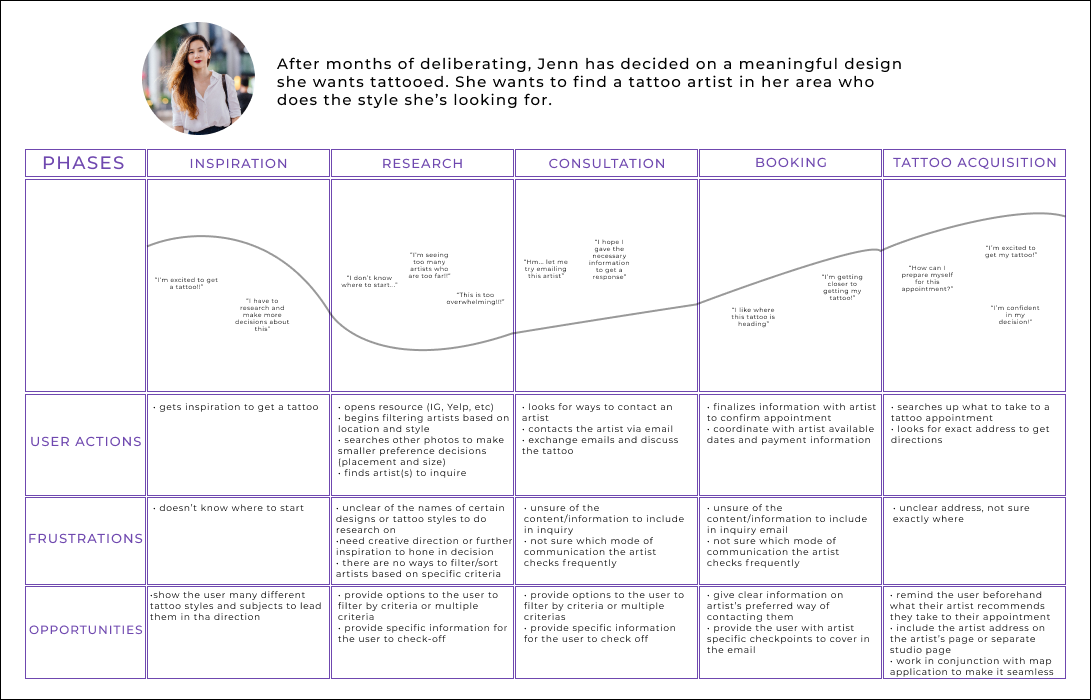InkLink
Getting a tattoo is a pretty big commitment, so the research in choosing the right artist should reflect that. For me, that meant alternating between three different apps, browsing through thousands of artist profiles for hours at a time. The process? Frustrating.
If I found an artist I liked? Great! Except they were based in Korea. Found one nearby? Sorry, fully booked until 2025. After what felt like the hundredth “almost,” I started wondering: why isn’t there a better way to do this?
I figured I couldn’t be the only one, so I set out to validate the pain points with some user research.
User Interviews
To better understand the landscape, I interviewed 10 people with a range of tattoo experiences, from first-timers to seasoned collectors. Here’s what came up again and again:
People want search results tailored to their needs. They want filters that actually matter: Style, location, price range, availability.
They don’t want to waste time. It’s common to spend hours exploring an artist only to find out they're booked indefinitely or not taking new clients.
They expect reliable, up-to-date info. Too often, basic details like price estimates or booking status are missing.
Trust in the artist is everything. If someone’s going to put permanent art on your body, you want to know you’re on the same page.
Communication is key. Clear, easy contact with the artist helps reduce anxiety and build trust.
Current Pain Points
The common “link”? Everyone wanted a smoother way to discover, evaluate, and connect with tattoo artists. But the current platforms weren’t cutting it.
The key issues:
No organized way to search through a sea of artists.
Outdated or missing info makes planning difficult.
No sense of connection between client and artist.
Meet Cara, Jenn, and Chris
I created journey maps for three personas, each with different goals and frustrations.
Cara is getting her first tattoo and feels overwhelmed by options.
Jenn has a clear vision and wants an artist who matches her style.
Chris is traveling and needs someone local with availability soon.
These maps helped me empathize and highlight different emotional peaks and valleys in the process.
Brainstorming
I teamed up with a brainstorming buddy to bring some fresh perspective. We tackled three main questions:
How might we show users artists that truly match their preferences?
How might we improve communication between artists and clients?
How might we help users feel confident before and after they book?
From these discussions, the idea for InkLink was born.
Designing InkLink
InkLink is designed to streamline the tattoo artist discovery process and help users feel confident from start to finish. Here's how it works:
Users set their criteria: location, style, budget, availability
Artist profiles are curated to match: No more endless, irrelevant scrolling
Users can view portfolios, bookmark artists, or veto and move on
The goal is to make each profile feel like a solid lead, not a gamble. For that, there is a second feature: the Artist Feed, a personalized stream of activity from artists a user has bookmarked or worked with.
Read real reviews: through unfiltered reviews and feedback from real, verified clients
Track consistency: follow an artist’s work and healed tattoos over time before committing
Stay informed: be in-the-know with new updates, posts, and policy changes an artist may have
Sketches & Wireframes
I started with low-fidelity sketches. The focus was on reducing friction during discovery, while building features that encourage trust and long-term connection with artists. This resulted in two key flows:
Curated Artist Discovery – a swipeable, filter-based experience where users explore portfolios based on their preferences.
The Artist Feed – a dynamic stream where users keep up with bookmarked artists through posts, healed work, and client reviews.
Prototype
I translated my concept into a clickable prototype to explore user flow and interaction. This step brought InkLink to life, allowing me to simulate the curated artist discovery experience and the personalized Artist Feed in a way that felt real and testable.
InkLink wasn’t just about building a prettier directory—it was about rethinking how we connect with the artists behind the ink. By centering real user frustrations and building with empathy, I created a tool that takes the stress out of an already big decision.
And as a tattoo lover myself? I finally feel like I can get excited about the process again.
Takeaways
InkLink was my first UX case study and the project that sparked my deeper interest in user research. What started as a personal pain point turned into a hands-on opportunity to explore user needs, decision-making, and trust through design. Asking those questions led me to pursue academic research in Human-Computer Interaction, where I now explore how people engage with technology in everyday contexts.








